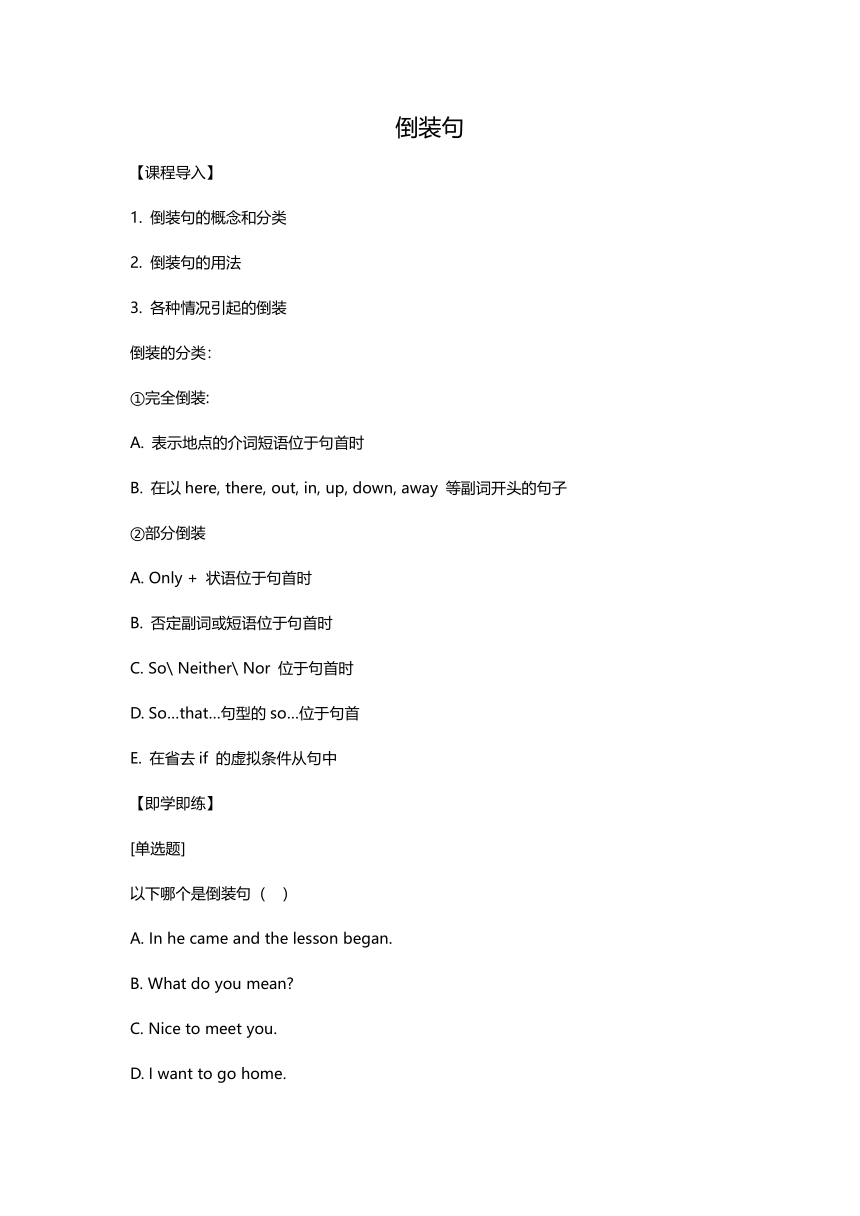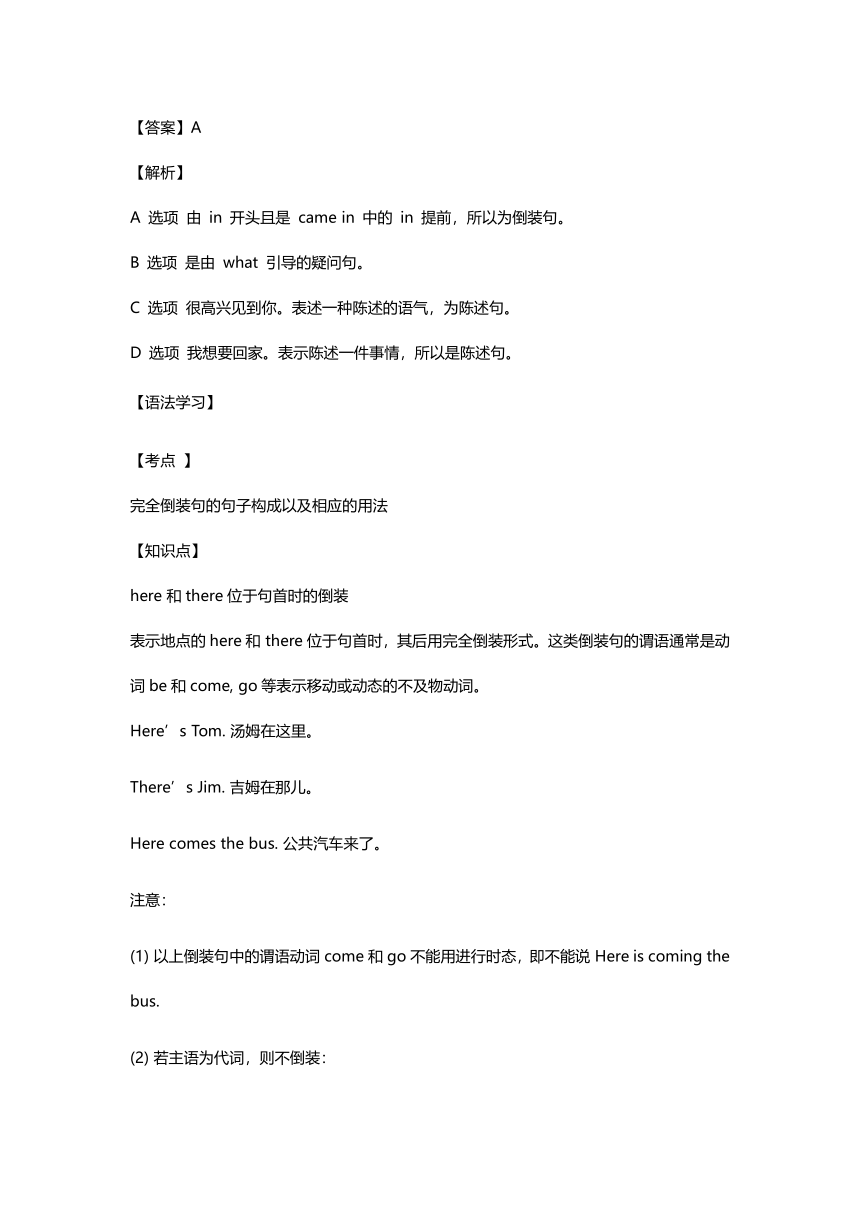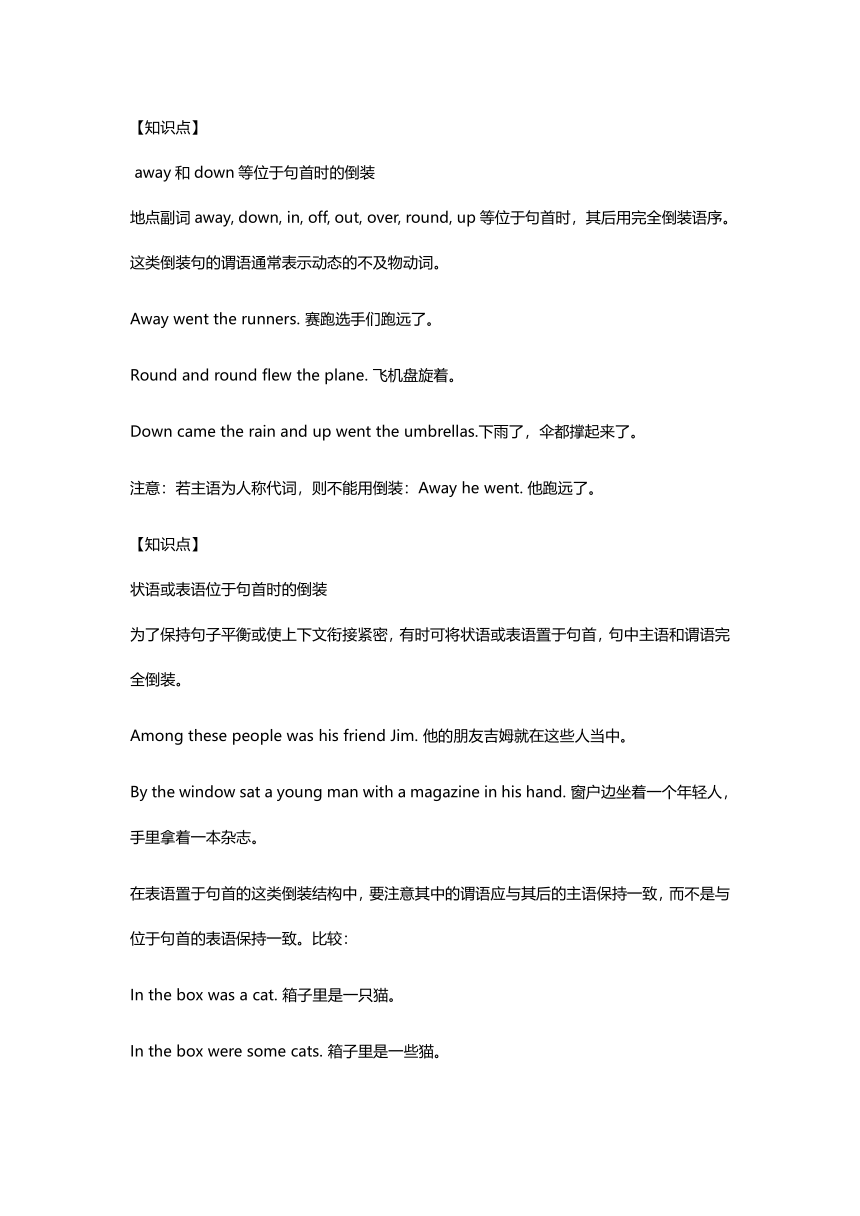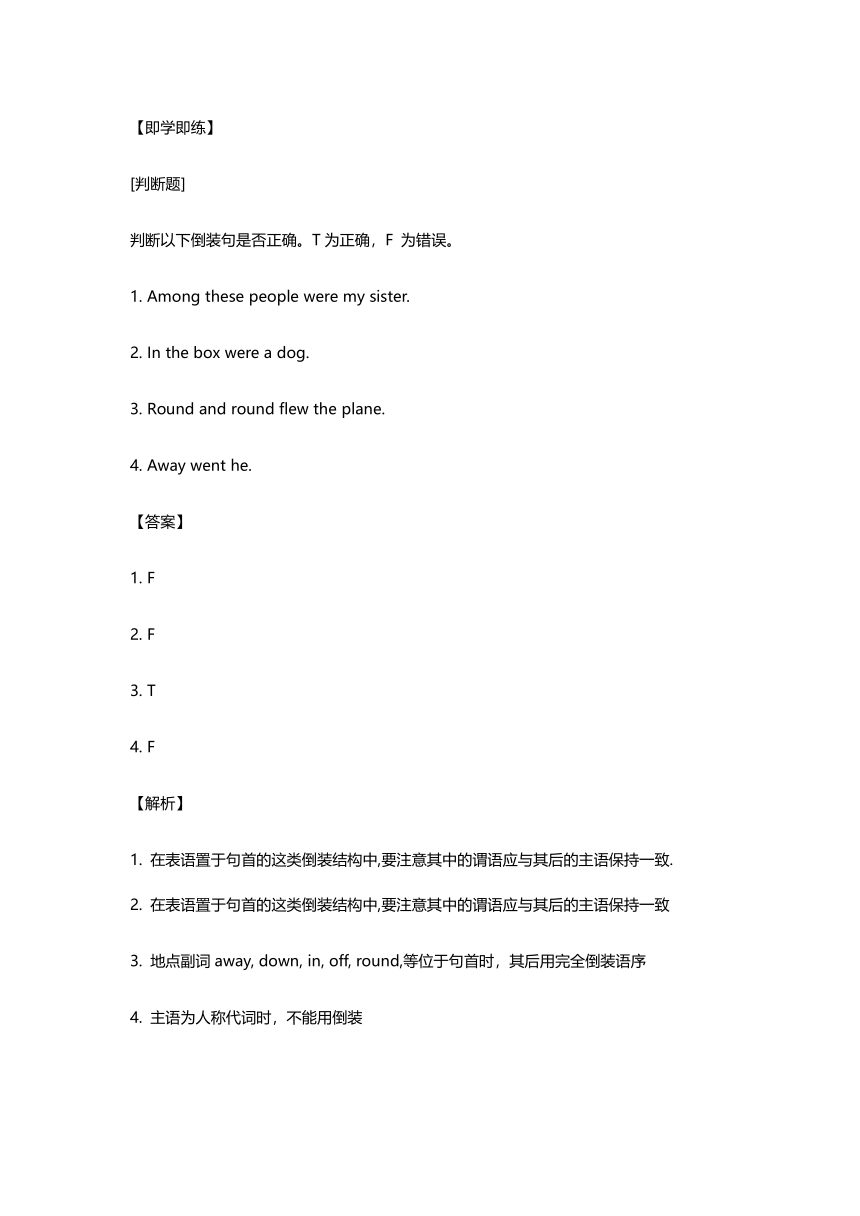初中语法知识点学案_lesson36倒装句
文档属性
| 名称 | 初中语法知识点学案_lesson36倒装句 |  | |
| 格式 | docx | ||
| 文件大小 | 22.8KB | ||
| 资源类型 | 试卷 | ||
| 版本资源 | 通用版 | ||
| 科目 | 英语 | ||
| 更新时间 | 2021-08-18 14:06:06 | ||
图片预览





文档简介
倒装句
【课程导入】
1. 倒装句的概念和分类
2. 倒装句的用法
3. 各种情况引起的倒装
倒装的分类:
①完全倒装:
A. 表示地点的介词短语位于句首时
B. 在以here, there, out, in, up, down, away 等副词开头的句子
②部分倒装
A. Only + 状语位于句首时
B. 否定副词或短语位于句首时
C. So\ Neither\ Nor 位于句首时
D. So…that…句型的so…位于句首
E. 在省去if 的虚拟条件从句中
【即学即练】
[单选题]
以下哪个是倒装句( )
A. In he came and the lesson began.
B. What do you mean?
C. Nice to meet you.
D. I want to go home.
【答案】A
【解析】
A 选项 由 in 开头且是 came in 中的 in 提前,所以为倒装句。
B 选项 是由 what 引导的疑问句。
C 选项 很高兴见到你。表述一种陈述的语气,为陈述句。
D 选项 我想要回家。表示陈述一件事情,所以是陈述句。
【语法学习】
【考点 】
完全倒装句的句子构成以及相应的用法
【知识点】
here?和there位于句首时的倒装
表示地点的here和?there位于句首时,其后用完全倒装形式。这类倒装句的谓语通常是动词be和come, go等表示移动或动态的不及物动词。
Here’s Tom.?汤姆在这里。
There’s Jim.?吉姆在那儿。
Here comes the bus.?公共汽车来了。
注意:
(1)?以上倒装句中的谓语动词come和go不能用进行时态,即不能说?Here is coming the bus.
(2)?若主语为代词,则不倒装:
Here I am.?我在这儿。/?我来了。
Here it comes.?它来了。
(3)?其中的动词有时也可能是stand, lie, live等表示状态的动词(表示存在):
There stood a desk against the wall.?靠墙放着一张书桌。
【即学即练】
[多选题]
以下哪些倒装句的表述是正确的( )
Here are you.
Here is coming Tom.
There stood a desk against the wall.
There’s Jim.
【答案】C.D
【解析】
A 选项 当主语为代词时,不倒装。
B 选项 倒装句中的谓语动词是come 和go 时不能用进行时态。
C 选项 倒装句中的动词有时也可以是 stand等表示状态的动词。
D 选项 表示地点的here和?there位于句首时,其后用完全倒装形式。
【知识点】
?away和down等位于句首时的倒装
地点副词away, down, in, off, out, over, round, up等位于句首时,其后用完全倒装语序。这类倒装句的谓语通常表示动态的不及物动词。
Away went the runners.?赛跑选手们跑远了。
Round and round flew the plane.?飞机盘旋着。
Down came the rain and up went the umbrellas.下雨了,伞都撑起来了。
注意:若主语为人称代词,则不能用倒装:Away he went.?他跑远了。
【知识点】
状语或表语位于句首时的倒装
为了保持句子平衡或使上下文衔接紧密,有时可将状语或表语置于句首,句中主语和谓语完全倒装。
Among these people was his friend Jim.?他的朋友吉姆就在这些人当中。
By the window sat a young man with a magazine in his hand.?窗户边坐着一个年轻人,手里拿着一本杂志。
在表语置于句首的这类倒装结构中,要注意其中的谓语应与其后的主语保持一致,而不是与位于句首的表语保持一致。比较:
In the box was a cat.?箱子里是一只猫。
In the box were some cats.?箱子里是一些猫。
【即学即练】
[判断题]
判断以下倒装句是否正确。T为正确,F 为错误。
1. Among these people were my sister.
2. In the box were a dog.
3. Round and round flew the plane.?
4. Away went he.
【答案】
1. F
2. F
3. T
4. F
【解析】
1. 在表语置于句首的这类倒装结构中,要注意其中的谓语应与其后的主语保持一致.
2. 在表语置于句首的这类倒装结构中,要注意其中的谓语应与其后的主语保持一致
3. 地点副词away, down, in, off, round,等位于句首时,其后用完全倒装语序
4. 主语为人称代词时,不能用倒装
【知识点】?
分词和不定式置于句首的倒装
有时为了强调,可将谓语部分的现在分词、过去分词或不定式置于句首,从而构成倒装。
Buried in the sands was an ancient village.?一个古老的村庄被埋在这沙土之中。
Standing beside the table was his wife.?站在桌旁的是他的妻子。
To be carefully considered are the following questions.?下列问题要仔细考虑
【即学即练】
[单选题]
( ) in the sand beach was a beautiful shell.
A. Buried B. Burring C. bury D. Burying
【答案】A
【解析】一个美丽的贝壳被埋在沙滩上。有时为了强调,可将谓语部分的现在分词、过去分词或不定式置于句首,从而构成倒装。本句表示被动形式,因此选择A
【考点 】
部分倒装的构成以及相应的用法
【知识点】
否定副词位于句首时的倒装
在正式文体中,never, seldom, rarely, little, hardly, scarcely, no sooner, no longer, nowhere?等含有否定意义的副词若位于句首,则其后要用部分倒装。?
I shall never forgive him. / Never shall I forgive him.?我永远不会宽恕他。
He seldom goes out for dinner. / Seldom does he go out for dinner.?他很少出去吃饭。
She hardly has time to listen to music. / Hardly does she have time to listen to music.?她几乎没时间听音乐。
(1)?对于not…until句型,当not until…位于句首时,其后的主句要用倒装语序.
(2)?某些起副词作用的介词短语,由于含有否定词,若位于句首,其后要用部分倒装
但是,in no time(立即,马上)位于句首时,其后无需用倒装语序
【即学即练】
[单选题]
1. In no time he( )the problem.?
A. worked out B. out worked C. Worked D. work
2. Not until the rain stopped( )the room.
A. he leaved B. left C. did he leave D. he did leave
【答案】
1. A
2. C
【解析】
1. in no time(立即,马上)位于句首时,其后无需用倒装语序。
2. 对于not…until句型,当not until…位于句首时,其后的主句要用倒装语序。
【知识点】
“only+状语”位于句首时的倒装
当一个状语受副词only的修饰且置于句首时,其后用部分倒装语序。
Only then did he realize that he was wrong.?到那时他才意识到他错了。
Only in this way are you able to do it well.?你只有用这种方法才能把它做好。
Only when he returned home did he realize what had happened.?当他回到家里时,才知道出了什么事。
【即学即练】
[单选题]
1. Only then( ) how much damage had been caused.
A. She realized B. she had realized C. had she realized D. did she realized
2. Only after my friend came( ).?
A. did the computer repaired????????????????????
B. be repaired the computer
C. was the computer repaired???????????????????
D. the computer was repaired
【答案】
1. D
2. C
【解析】
1. 当一个状语受副词only的修饰且置于句首时,其后用部分倒装语序。由句尾的 had been caused 推断出要用过去式。
2. 当一个状语受副词only的修饰且置于句首时,其后用部分倒装语序。由 came 推断出要用过去式,电脑是被打开,因此要用被动句。
【知识点】
“so + adj. / adv.” 位于句首时的倒装
副词so后接形容词或副词位于句首时,其后用部分倒装
So cold was the weather that we had to stay at home.?天气太冷,我们只好呆在家里。
So fast does light travel that we can hardly imagine its speed.?光速很快,我们几乎没法想像它的速度。
So sudden was the attack that we had no time to escape.?袭击来得非常突然,我们来不及逃跑。
若前面提出某一否定的情况,要表示后者也属于同样的否定情况,则应将其中的so改为neither或nor.
You aren’t young and neither am I.?你不年轻,我也不年轻。
She hasn’t read it and nor have I.?她没有读它,我也没有读。
【即学即练】
[单选题]
1.?So difficult( ) it to work out the problem that I decided to ask Tom for advice.?
A. I did find???????????? B. did I find?????????? C. I have found???????? D. have I found
2. Mary never does any reading in the evening, ( ).
A. so does John???????????????????????????? B. John does too
C. John doesn’t too??????????????????????? D. nor does?John
【答案】
1. B
2. D
【解析】
1. 副词so后接形容词或副词位于句首时,其后用部分倒装。decided 显示整句的是时态为过去。
2. 若前面提出某一否定的情况,要表示后者也属于同样的否定情况,则应将其中的so改为neither或nor。
【知识点】
“so+助动词+主语”倒装
当要表示前面提出的某一肯定的情况也同样适合于后者,通常就要用“So+助动词+主语”这种倒装结构。
You are young and so am I.?你年轻,我也年轻。
She likes music and so do I.?她喜欢音乐,我也喜欢。
If he can do it, so can I.?要是他能做此事,我也能。
(1)?若前面提出某一否定的情况,要表示后者也属于同样的否定情况,则应将其中的so改为neither或nor.
(2)?注意该结构与表示强调或同意的“so+主语+特殊动词”结构的区别.
You aren’t young and neither am I.?你不年轻,我也不年轻。
"It was cold yesterday." "So it was." “昨天很冷。”“的确很冷。”
【即学即练】
[单选题]
— It’s burning hot today, isn’t it?
— Yes.( ) yesterday.?
A. So was it??????????? B. So it was???????????? C. So it is?????????????? D. So is it
【答案】A
【解析】倒装结构为“so+助动词+主语”
?【知识点】
由not only…but also引出的倒装
当not only…but also位于句首引出句子时,not only后的句子通常用部分倒装形式,but also后的分句不用倒装。
Not only is he a teacher, but he is also a poet.他不仅是一位教师,而且是一位诗人。
Not only did he speak more correctly, but he spoke more easily.?不仅他讲得更正确,也讲得更不费劲了。
【即学即练】
[单选题]
Not only( )a musical performance, but they also gave a brief introduction to the history of Western brass instruments.?
A. did they present B. they present C. does they present D. present
【答案】A
【解析】当not only…but also位于句首引出句子时,not only后的句子通常用部分倒装形式。后半部分句子的时态为过去,句子前后时态要保持一致。
?【知识点】
虚拟条件句的省略与倒装
当if引导的虚拟条件从句中含有had, were, should等时,如将if省略,则要将had, were, should等移到主语前,构成倒装句。
Had you come yesterday, you would have seen him.若你昨天来,你就会见到他了。
Should you require anything just give me a ring.?要是需要什么东西就给我打电话。
省略if后提前的had不一定是助动词:
Had I money, I would buy it.?假若我有钱,我就会买它。
【即学即练】
[单选题]
( )it not for your help, I would still be homeless.
A. Were B. were C. if D. if were
【答案】A
【解析】当if引导的虚拟条件从句中含有had, were, should等时,如将if省略,则要将had, were, should等移到主语前,构成倒装句。首句的字母需要大写。
【课程导入】
1. 倒装句的概念和分类
2. 倒装句的用法
3. 各种情况引起的倒装
倒装的分类:
①完全倒装:
A. 表示地点的介词短语位于句首时
B. 在以here, there, out, in, up, down, away 等副词开头的句子
②部分倒装
A. Only + 状语位于句首时
B. 否定副词或短语位于句首时
C. So\ Neither\ Nor 位于句首时
D. So…that…句型的so…位于句首
E. 在省去if 的虚拟条件从句中
【即学即练】
[单选题]
以下哪个是倒装句( )
A. In he came and the lesson began.
B. What do you mean?
C. Nice to meet you.
D. I want to go home.
【答案】A
【解析】
A 选项 由 in 开头且是 came in 中的 in 提前,所以为倒装句。
B 选项 是由 what 引导的疑问句。
C 选项 很高兴见到你。表述一种陈述的语气,为陈述句。
D 选项 我想要回家。表示陈述一件事情,所以是陈述句。
【语法学习】
【考点 】
完全倒装句的句子构成以及相应的用法
【知识点】
here?和there位于句首时的倒装
表示地点的here和?there位于句首时,其后用完全倒装形式。这类倒装句的谓语通常是动词be和come, go等表示移动或动态的不及物动词。
Here’s Tom.?汤姆在这里。
There’s Jim.?吉姆在那儿。
Here comes the bus.?公共汽车来了。
注意:
(1)?以上倒装句中的谓语动词come和go不能用进行时态,即不能说?Here is coming the bus.
(2)?若主语为代词,则不倒装:
Here I am.?我在这儿。/?我来了。
Here it comes.?它来了。
(3)?其中的动词有时也可能是stand, lie, live等表示状态的动词(表示存在):
There stood a desk against the wall.?靠墙放着一张书桌。
【即学即练】
[多选题]
以下哪些倒装句的表述是正确的( )
Here are you.
Here is coming Tom.
There stood a desk against the wall.
There’s Jim.
【答案】C.D
【解析】
A 选项 当主语为代词时,不倒装。
B 选项 倒装句中的谓语动词是come 和go 时不能用进行时态。
C 选项 倒装句中的动词有时也可以是 stand等表示状态的动词。
D 选项 表示地点的here和?there位于句首时,其后用完全倒装形式。
【知识点】
?away和down等位于句首时的倒装
地点副词away, down, in, off, out, over, round, up等位于句首时,其后用完全倒装语序。这类倒装句的谓语通常表示动态的不及物动词。
Away went the runners.?赛跑选手们跑远了。
Round and round flew the plane.?飞机盘旋着。
Down came the rain and up went the umbrellas.下雨了,伞都撑起来了。
注意:若主语为人称代词,则不能用倒装:Away he went.?他跑远了。
【知识点】
状语或表语位于句首时的倒装
为了保持句子平衡或使上下文衔接紧密,有时可将状语或表语置于句首,句中主语和谓语完全倒装。
Among these people was his friend Jim.?他的朋友吉姆就在这些人当中。
By the window sat a young man with a magazine in his hand.?窗户边坐着一个年轻人,手里拿着一本杂志。
在表语置于句首的这类倒装结构中,要注意其中的谓语应与其后的主语保持一致,而不是与位于句首的表语保持一致。比较:
In the box was a cat.?箱子里是一只猫。
In the box were some cats.?箱子里是一些猫。
【即学即练】
[判断题]
判断以下倒装句是否正确。T为正确,F 为错误。
1. Among these people were my sister.
2. In the box were a dog.
3. Round and round flew the plane.?
4. Away went he.
【答案】
1. F
2. F
3. T
4. F
【解析】
1. 在表语置于句首的这类倒装结构中,要注意其中的谓语应与其后的主语保持一致.
2. 在表语置于句首的这类倒装结构中,要注意其中的谓语应与其后的主语保持一致
3. 地点副词away, down, in, off, round,等位于句首时,其后用完全倒装语序
4. 主语为人称代词时,不能用倒装
【知识点】?
分词和不定式置于句首的倒装
有时为了强调,可将谓语部分的现在分词、过去分词或不定式置于句首,从而构成倒装。
Buried in the sands was an ancient village.?一个古老的村庄被埋在这沙土之中。
Standing beside the table was his wife.?站在桌旁的是他的妻子。
To be carefully considered are the following questions.?下列问题要仔细考虑
【即学即练】
[单选题]
( ) in the sand beach was a beautiful shell.
A. Buried B. Burring C. bury D. Burying
【答案】A
【解析】一个美丽的贝壳被埋在沙滩上。有时为了强调,可将谓语部分的现在分词、过去分词或不定式置于句首,从而构成倒装。本句表示被动形式,因此选择A
【考点 】
部分倒装的构成以及相应的用法
【知识点】
否定副词位于句首时的倒装
在正式文体中,never, seldom, rarely, little, hardly, scarcely, no sooner, no longer, nowhere?等含有否定意义的副词若位于句首,则其后要用部分倒装。?
I shall never forgive him. / Never shall I forgive him.?我永远不会宽恕他。
He seldom goes out for dinner. / Seldom does he go out for dinner.?他很少出去吃饭。
She hardly has time to listen to music. / Hardly does she have time to listen to music.?她几乎没时间听音乐。
(1)?对于not…until句型,当not until…位于句首时,其后的主句要用倒装语序.
(2)?某些起副词作用的介词短语,由于含有否定词,若位于句首,其后要用部分倒装
但是,in no time(立即,马上)位于句首时,其后无需用倒装语序
【即学即练】
[单选题]
1. In no time he( )the problem.?
A. worked out B. out worked C. Worked D. work
2. Not until the rain stopped( )the room.
A. he leaved B. left C. did he leave D. he did leave
【答案】
1. A
2. C
【解析】
1. in no time(立即,马上)位于句首时,其后无需用倒装语序。
2. 对于not…until句型,当not until…位于句首时,其后的主句要用倒装语序。
【知识点】
“only+状语”位于句首时的倒装
当一个状语受副词only的修饰且置于句首时,其后用部分倒装语序。
Only then did he realize that he was wrong.?到那时他才意识到他错了。
Only in this way are you able to do it well.?你只有用这种方法才能把它做好。
Only when he returned home did he realize what had happened.?当他回到家里时,才知道出了什么事。
【即学即练】
[单选题]
1. Only then( ) how much damage had been caused.
A. She realized B. she had realized C. had she realized D. did she realized
2. Only after my friend came( ).?
A. did the computer repaired????????????????????
B. be repaired the computer
C. was the computer repaired???????????????????
D. the computer was repaired
【答案】
1. D
2. C
【解析】
1. 当一个状语受副词only的修饰且置于句首时,其后用部分倒装语序。由句尾的 had been caused 推断出要用过去式。
2. 当一个状语受副词only的修饰且置于句首时,其后用部分倒装语序。由 came 推断出要用过去式,电脑是被打开,因此要用被动句。
【知识点】
“so + adj. / adv.” 位于句首时的倒装
副词so后接形容词或副词位于句首时,其后用部分倒装
So cold was the weather that we had to stay at home.?天气太冷,我们只好呆在家里。
So fast does light travel that we can hardly imagine its speed.?光速很快,我们几乎没法想像它的速度。
So sudden was the attack that we had no time to escape.?袭击来得非常突然,我们来不及逃跑。
若前面提出某一否定的情况,要表示后者也属于同样的否定情况,则应将其中的so改为neither或nor.
You aren’t young and neither am I.?你不年轻,我也不年轻。
She hasn’t read it and nor have I.?她没有读它,我也没有读。
【即学即练】
[单选题]
1.?So difficult( ) it to work out the problem that I decided to ask Tom for advice.?
A. I did find???????????? B. did I find?????????? C. I have found???????? D. have I found
2. Mary never does any reading in the evening, ( ).
A. so does John???????????????????????????? B. John does too
C. John doesn’t too??????????????????????? D. nor does?John
【答案】
1. B
2. D
【解析】
1. 副词so后接形容词或副词位于句首时,其后用部分倒装。decided 显示整句的是时态为过去。
2. 若前面提出某一否定的情况,要表示后者也属于同样的否定情况,则应将其中的so改为neither或nor。
【知识点】
“so+助动词+主语”倒装
当要表示前面提出的某一肯定的情况也同样适合于后者,通常就要用“So+助动词+主语”这种倒装结构。
You are young and so am I.?你年轻,我也年轻。
She likes music and so do I.?她喜欢音乐,我也喜欢。
If he can do it, so can I.?要是他能做此事,我也能。
(1)?若前面提出某一否定的情况,要表示后者也属于同样的否定情况,则应将其中的so改为neither或nor.
(2)?注意该结构与表示强调或同意的“so+主语+特殊动词”结构的区别.
You aren’t young and neither am I.?你不年轻,我也不年轻。
"It was cold yesterday." "So it was." “昨天很冷。”“的确很冷。”
【即学即练】
[单选题]
— It’s burning hot today, isn’t it?
— Yes.( ) yesterday.?
A. So was it??????????? B. So it was???????????? C. So it is?????????????? D. So is it
【答案】A
【解析】倒装结构为“so+助动词+主语”
?【知识点】
由not only…but also引出的倒装
当not only…but also位于句首引出句子时,not only后的句子通常用部分倒装形式,but also后的分句不用倒装。
Not only is he a teacher, but he is also a poet.他不仅是一位教师,而且是一位诗人。
Not only did he speak more correctly, but he spoke more easily.?不仅他讲得更正确,也讲得更不费劲了。
【即学即练】
[单选题]
Not only( )a musical performance, but they also gave a brief introduction to the history of Western brass instruments.?
A. did they present B. they present C. does they present D. present
【答案】A
【解析】当not only…but also位于句首引出句子时,not only后的句子通常用部分倒装形式。后半部分句子的时态为过去,句子前后时态要保持一致。
?【知识点】
虚拟条件句的省略与倒装
当if引导的虚拟条件从句中含有had, were, should等时,如将if省略,则要将had, were, should等移到主语前,构成倒装句。
Had you come yesterday, you would have seen him.若你昨天来,你就会见到他了。
Should you require anything just give me a ring.?要是需要什么东西就给我打电话。
省略if后提前的had不一定是助动词:
Had I money, I would buy it.?假若我有钱,我就会买它。
【即学即练】
[单选题]
( )it not for your help, I would still be homeless.
A. Were B. were C. if D. if were
【答案】A
【解析】当if引导的虚拟条件从句中含有had, were, should等时,如将if省略,则要将had, were, should等移到主语前,构成倒装句。首句的字母需要大写。
同课章节目录
- 词法
- 名词
- 动词和动词短语
- 动词语态
- 动词时态
- 助动词和情态动词
- 非谓语动词
- 冠词
- 代词
- 数词和量词
- 形容词副词及其比较等级
- 介词和介词短语
- 连词和感叹词
- 构词法
- 相似、相近词比较
- 句法
- 陈述句
- 一般疑问句和否定疑问句
- 特殊疑问句及选择疑问句
- 反意疑问句
- 存在句(There be句型)
- 宾语从句
- 定语从句
- 状语从句
- 主谓一致问题
- 简单句
- 并列句
- 复合句
- 主谓一致
- 主、表语从句
- 名词性从句
- 直接引语和间接引语
- 虚拟语气
- 感叹句
- 强调句
- 倒装句
- 祈使句
- 句子的成分
- 句子的分类
- 题型专区
- 单项选择部分
- 易错题
- 完形填空
- 阅读理解
- 词汇练习
- 听说训练
- 句型转换
- 补全对话
- 短文改错
- 翻译
- 书面表达
- 任务型阅读
- 语法填空
- 其他资料
